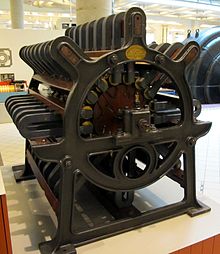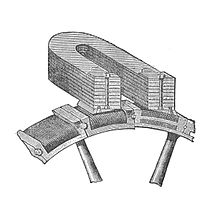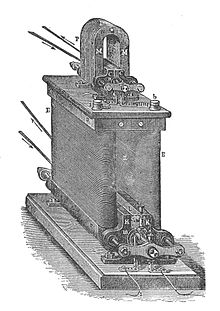- Magneto (generator)
-
This article is about magnetos as electrical generators. For other electrical uses, see Magneto.
A magneto is an electrical generator that uses permanent magnets to produce alternating current. Unlike a dynamo, there is no commutator and so they cannot produce direct current. They are categorised as a form of alternator, although they are usually regarded as distinct from most other alternators, which use field coils rather than permanent magnets.
Magnetos date from the earliest days of electrical engineering. Despite this, they have never been widely applied for the purposes of bulk electricity generation, for the same purposes or to the same extent as either dynamos or alternators.
Contents
Common uses of magnetos
Magnetos have advantages of simplicity and reliability, but are inefficient owing to the weak magnetic flux available from their permanent magnets. This restricted their use for high-power applications.
Some magnetos did find use as telephone magnetos in early telephones, particularly for ringing.
The most common application for magnetos was as an ignition magneto, in spark-ignition petrol engines, ranging from early cars to aircraft (for reliability) and small engines such as chainsaws (for simplicity).
Magnetos for power generation
Early power generation systems adopted bipolar dynamos as their generators. These had a two-pole stator with a field winding. It could generate considerable flux, and thus power, for the time. They also required a commutator to produce a direct current (DC) output, which was complex to make and required regular maintenance. In contrast magnetos were not generally used, as they were inadequately powerful.
Arc lighting
Most early dynamos were bipolar[note 1] and so their output varied cyclically as the armature rotated past the two poles.
To achieve an adequate output power, magneto generators used many more poles; usually sixteen, from eight horseshoe magnets arranged in a ring. As the flux available was limited by the magnet metallurgy, the only option was to increase the field by using more magnets. As this was still an inadequate power, extra rotor disks were stacked axially, along the axle. This had the advantage that each rotor disk could at least share the flux of two expensive magnets. The machine illustrated here uses eight disks and nine rows of magnets: 72 magnets in all.
The rotors first used were wound as sixteen axial bobbins, one per pole. Compared to the bipolar dynamo, this did have the advantage of more poles giving a smoother output per rotation,[note 2] which was an advantage when driving arc lamps. Magnetos thus established a small niche for themselves as lighting generators.
The Belgian electrical engineer Floris Nollet became particularly known for this type of arc lighing generator and founded the British-French company Société de l'Alliance to manufacture them.
The French engineer Auguste de Méritens developed magnetos further for this purpose.[1] His innovation was to replace the rotor coils previously wound on individual bobbins, with a 'ring wound' armature.[2] These windings were wound on a segmented iron core, similar to a Gramme ring, so as to form a single continuous hoop. This gave a more even output current, which was still more advantageous for arc lamps.[3]
Lighthouses
 Auguste de Méritens' lighthouse generator
Auguste de Méritens' lighthouse generator
de Méritens is best remembered today for his production of magneto generators specifically for lighthouses. These were favoured for their simplicity and reliability, in particular their avoidance of commutators.[3] In the sea air of a lighthouse, the commutator that had been used previously with dynamo generators was a continual source of trouble. The lighthouse keepers of the time, usually semi-retired sailors, were not mechanically or electrically skilled to maintain these more complex machines.
The de Méritens magneto generator illustrated shows the 'ring wound' armature. As there is now only a single rotor disk, the horseshoe magnets used are stacked together in groups, but act through a single pole piece.
Self-exciting dynamos
Both dynamos and alternators required a source of power to drive their field coils. This could not be supplied by their own generator's output, without some process of 'bootstrapping'.
Wilde, an electrical engineer of Manchester, developed a combination of magneto and electro-magnet generator, where the magneto was used only to supply the field to the larger alternator. These are illustrated in Rankin Kennedy's work Electrical Installations[4] Kennedy himself developed a simpler version of this, intended for lighting use on ships, where a dynamo and magneto were assembled on the same shaft.[5] Kennedy's innovation here was to avoid the need for brushgear altogether. The current generated in the magneto is transmitted by wires attached to the rotating shaft to the dynamo's rotating field coil. The output of the dynamo is then taken from the stator coils. This is 'inside-out' compared to the conventional dynamo, but avoids the need for brushgear.
The invention of the self-exciting field by Varley, Siemens & Wheatstone removed the need for a magneto exciter. A small residual field in the iron armature of the field coils acted as a weak permanent magnet, and thus a magneto. The shunt wiring of the generator feeds some of its output current back into the field coils, which in turn increases output. By this means the field 'builds up' regeneratively, although this may take 20-30 seconds to do so fully.[6]
Although the use of magnetos here is now obsolete, separate exciters are still used for high power generating sets, as they permit easier control of output power. These are particularly common with the transmissions of diesel-electric locomotives.
Low-power magnetos
For their simplicity, particularly their independence from a stored power source, magnetos have found some use for low-power electricity generation, usually human-powered. The best known of these is the cycle lamp bottle dynamo. Despite their name, these dynamos were usually [note 3] AC magnetos.
Similar magnetos have also been used in hand torches.
Future possibilities
The modern development of rare earth magnets makes the simple magneto alternator a more practical proposition as a power generator, as these permit a greatly increased field strength. As the magnets are compact and of light weight, they generally form the rotor, allowing the output windings to be placed on the stator, avoiding the need for brushgear.
Guided missiles
By the late 1980s, developments in magnetic materials such as samarium cobalt allowed permanent magnet alternators to be used where an extremely robust generator is required. In guided missiles, such generators may replace the flux switching alternator.[7] These need to operate at high speeds, directly coupled to a turbine. Both types share the advantage of the output coils being part of the stator, thus avoiding the need for brushgear.
Wind turbines
Small wind turbines, particularly self-build designs, are widely adopting magneto alternators for their generators. These use rotating neodymium rare-earth magnets with a three-phase stator, then a bridge rectifier to produce DC. This is then used either directly for water-pumping, stored in batteries, or used to drive a mains inverter which can supply the grid system for profit. These designs have been encouraged by one of the most popular self-build designs, described in Hugh Piggott's series of books and courses.[8][9] A typical design here is an axial-flux generator recycled from a car brake disk and hub bearing. A Macpherson strut provides the azimuth bearing to bring the turbine into the wind.[10] The brake disk, and its attached rare-earth magnets, rotates to form the armature. A plywood disk carrying multiple axial coils is placed alongside this, with a further iron armature ring behind it.
References
- ^ See the related bipolar motor for a discussion of their development from bipolar to multipolar fields.
- ^ Actually a higher AC frequency.
- ^ A few late-model dynamos generated DC, usually by using a bridge rectifier rather than a commutator, so that they could charge batteries and thus maintain the lights when the bicycle was stopped at traffic junctions.
- ^ "Meritens, Baron Auguste de". Biographical Dictionary of the History of Technology. http://www.bookrags.com/tandf/meritens-baron-auguste-de-tf/.
- ^
 One or more of the preceding sentences incorporates text from a publication now in the public domain: Hawkins, Charles Caesar (1911). "Dynamo". In Chisholm, Hugh. Encyclopædia Britannica (11th ed.). Cambridge University Press.
One or more of the preceding sentences incorporates text from a publication now in the public domain: Hawkins, Charles Caesar (1911). "Dynamo". In Chisholm, Hugh. Encyclopædia Britannica (11th ed.). Cambridge University Press. - ^ a b Kennedy, Rankin (1903). Electrical Installations. Vol. III (1903 edition (five volumes) of pre-1903 four volume edition ed.). London: Caxton. pp. 205—206.
- ^ Kennedy, Electrical Installations, Vol. III, 1903, p. 207
- ^ Kennedy, Electrical Installations, Vol. III, 1903, p. 208
- ^ Croft, Terrell (1917). Electrical Machinery. McGraw-Hill. p. 7.
- ^ Lee, Colonel R.G.; Garland-Collins, T.K.; D.E.Johnson, E.Archer, C.Sparkes. G.M.Moss, A.W.Mowat (1988). "Electrical Power Supplies". Guided Weapons. 1. Brassey's. p. 58. ISBN 0-08-035828-4.
- ^ Piggott, Hugh (2005). How to Build a Wind Turbine. http://www.scoraigwind.com/axialplans/index.htm.
- ^ Piggott, Hugh (2009). A Wind Turbine Recipe Book: Axial Flux Windmill Plans. http://www.scoraigwind.com/axialplans/index.htm.
- ^ "Construction of a 10' diameter Wind Turbine". http://www.otherpower.com/trips1.html.
Categories:- Electrical generators
Wikimedia Foundation. 2010.



